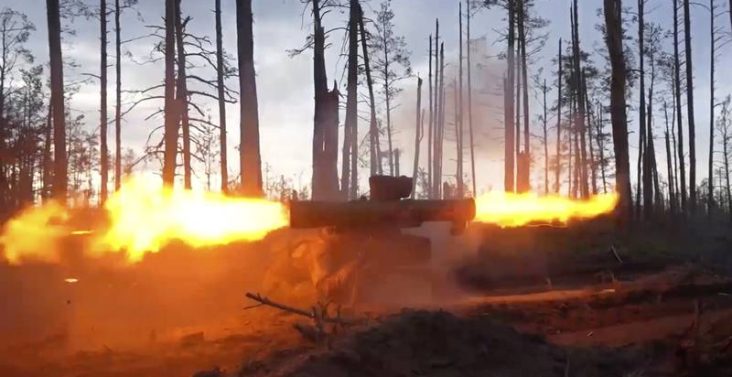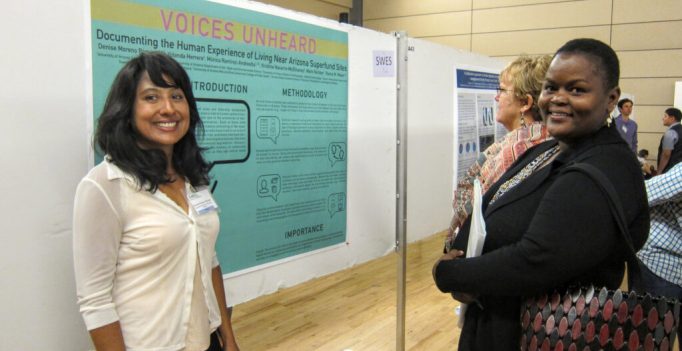Denise Moreno-Ramirez grew up in the border town of Nogales, Arizona, living in the U.S. with her family during the week and traveling to Mexico on weekends with her grandmother.
Near her small border community was Camp Little, a U.S. Army camp abandoned in 1933 that had been, by standards of the 1930s, cleaned up. But contaminants like chlorinated solvents from the untreated waste left behind had seeped into the groundwater and ultimately came out of people’s faucets in Moreno-Ramirez’s neighborhood.
Her community experienced steep rates of lupus and cancer, but no one knew why for years. Moreno-Ramirez recalls people coming to her high school science club to detail their suspicions that toxins were affecting her community, and beg anyone they could to recruit people or organizations to get to the bottom of it.
“Why aren’t people doing something for us?” she asked at the time. “That was really eye opening for me.”
Eventually, the alarming health issues in the town of fewer than 30,000 people caught the attention of organizations such as the Arizona Department of Environmental Quality and the Border Ecology Project.
Moreno-Ramirez knew she carried a unique perspective being from such a tight-knit but often forgotten community, and that there might be others similar to hers that suffer in silence because no one will take the time to hear their issues or concerns.
“I realized as a young individual that there were no scientists that looked or talked like me or had the same experiences like me,” she said. “And I realized as an individual sitting in Nogales, that that was really important for my community.”
The closer you are to the victims of the contamination, she said, the better you’ll understand the root problem and know how to deal with it most effectively.
This inspired her Voices Unheard dissertation project for her now-completed Ph.D. in Soil, Water, and Environmental Science at the University of Arizona, for which she gathered interviews from dozens of people who lived through a similar experience of toxic exposure to her own. Using their voices, she filled in gaps in history and provided nuance to scientific findings in Southern Arizona.

While oral history is far from a new concept, the ancient way of sharing environmental understanding through storytelling has lost value as technology has increasingly provided the answers to historical and scientific questions and placed them at the fingertips of anyone with a computer.
But scientists and historians alike are beginning to see advantages in connecting oral histories to textbooks, data charts and laboratory records the same way many indigenous communities have used storytelling to educate generations of their members and strived to keep the stories with critical information alive for centuries.
Unearthing the Hidden History of Mexican Miners in Arizona
Arizona is currently home to nine National Priorities List Superfund sites, including the Tucson Airport Area and Iron King Mine that closed in the 1960s. For her project, Moreno-Ramirez sat down with 11 people from both of those sites and simply asked them to tell their stories.
Not many original Iron King miners are alive today, but Moreno-Ramirez was able to track down two that still lived in the area. One, named Charlie Reyes Sr., was a driller at the Iron King mine who moved his whole family there for work. He told her about the people who used to live and work at the site and their experiences. He shared photos and journals and recalled how the environment had changed over the years.

“There was popular history that actually denies the Mexican minor’s place in that history,” Moreno-Ramirez said, but when she asked Reyes Sr. about the miners that worked with him, he said they were mostly Mexican.
“I’ll bet there was mostly, or 85 percent, Mexicans,” he said in his interview with Moreno-Ramirez. “They weren’t even miners, but they hired a lot of Mexicans” to do the mining.
But she didn’t just take the miners’ word for how common Mexicans were in the mines. Moreno-Ramirez then dug through archives from northern and central Arizona and found actual employee records for Iron King Mine. The records show a diverse group of people, many of Mexican descent.
“Well, of course,” Moreno-Ramirez’s mother responded when her daughter told her that she found that the Mexican miner had a more prevalent place at these sites than the history books had stated. “Your uncle Posada lived there.”
Pepe Posada was a well known baseball player in Hermosillo, Mexico, before he moved to Bisbee, Arizona, to work in the mines there, her mother told her.
“I never met him, but I always saw his picture on our wall,” Moreno-Ramirez said.
He was later transferred to Iron King mine in the city of Dewey-Humboldt, and made enough friends that the nearby community still remembers his name.
“It blew my mind that they actually knew my family. They knew my relatives,” she said. “They were like, ‘Actually your cousin still lives here,’ and I was like, ‘Woah.’”
Moreno-Ramirez was able to connect with her cousins in that area and realized a part of her own history that she never knew before.

As a medical anthropologist, Moreno-Ramirez needed to find a methodological lens that would help her interpret the data she was collecting for her project. Using Critical Race Theory, the school of thought, banned in some U.S. public education systems, that racial biases in the West have affected history, she was able to bring credibility to the community’s experiences and local knowledge that had been ignored in the collection of scientific data.
Leaving out the emotion behind the data is leaving out “a hell of alot,” according to Rib Davis, Chief of the Oral History Society based in the U.K.
“The answer isn’t just in science,” he said. “It’s in people.”
Davis and his team have compiled data and interviews to build a comprehensive oral history map that pinpoints different places across the globe where environmental oral history projects were performed. In a rapidly changing world, Davis created this passion project as a way to connect humans and add value to the conversations for controlling climate change.
Amplifying Community Stories Inspires Action
Before Moreno-Ramirez had decided to go back to school for her doctoral degree, she sat in on a unified community advisory board meeting for South Tucson, Arizona that discussed the illnesses that were sweeping over area residents from contaminated drinking water.
Yolanda Herrera, who was involved with the board, looked around for the missing community and board members, some who had been ill or died due to these afflictions, and called for action.
“She said, ‘A lot of our history is actually tied to these people, so when these people leave, then nobody really understands our history,’” Moreno-Ramirez said. “She asked me, ‘Is there anything that we can do?’ So basically, Voices Unheard was a direct question from the community that then I transformed into my dissertation project.”
Herrera is a fifth-generation Tucsonan. She grew up on the south side of town, where her family unknowingly drank from a well down the street from her home that was contaminated with chlorinated solvents, dioxane compounds and per- and polyfluorinated substances (PFAS ). Growing up, she noticed neighbors getting ill and knew that it couldn’t be normal.
“A lot of our classmates died at extremely young ages from different kinds of cancers because of the water contamination,” she recalled.
Her father knew something was terribly wrong, and in the early 1980s, he took his concerns to the U.S. EPA offices in Washington, D.C., and pleaded with them to perform a study to find the source of his community’s sicknesses. They listened, and began running tests and cleanup operations.

The surrounding areas had been filled with abandoned mines and military activity for generations, making it difficult to pinpoint the exact cause of the well contamination in her neighborhood, but residents knew it was killing members of the small and unsuspecting community at alarming rates.
By the time the well had been closed, it was too late. Herrera has multiple close friends and family members who are still being affected today by the contamination, including her mother, who recently passed away and her sister who has been diagnosed, both with a type of cancer.
Living in a desert, Herrera used to say “water is life,” but she knows first hand that it can be the opposite if it is not clean.
“You might as well be drinking poison, which we are,” she said.
Herrera hopes that the interview she contributed to the Voices Unheard collection of oral histories will open people’s eyes to the poverty that exists in towns like hers and inspire others to record the stories of their own communities.
Oral History Provides a Foundation for Citizen Science
As part of Moreno-Ramirez’s dissertation, she created a photo archive of pictures that her interview subjects provided to her and narrated. In one picture, she could see snow in an area that rarely gets it today. That’s when it clicked for her personally that oral histories can also contribute climate data.
People’s stories describing their daily observations don’t often carry much weight in the eyes of Western science, but organizations like the USA National Phenology Network are digitizing those oral histories and building a space where people’s lived experiences and observations are valued in the scientific world.
Their program, called Nature’s Notebook, is an open source data log that records people’s observations of everything from climate change to invasive species management and allergy trends. Using a phone app, participants can log changes they see in the environment over time. There’s even been more than 160 peer reviewed papers published using its citizen scientists’ data, according to Samantha Brewer, the volunteer engagement coordinator for the USA National Phenology Network.
“Even if you’re in a city or a really urban area that has landscaped trees that we walk past every day, these are still living things and they’re still part of the ecology of our city and our community,” said Brewer.
This story is funded by readers like you.
Our nonprofit newsroom provides award-winning climate coverage free of charge and advertising. We rely on donations from readers like you to keep going. Please donate now to support our work.
She recalls a group in New York that found both plant and climate data that was collected from farmers before the Civil War. The group digitized that information, and using Nature’s Notebook they then collected new data from the same locations.
“They were able to see that several plants were leafing out days or weeks earlier than they used to,” Brewer said.
Moving forward, Moreno-Ramirez hopes to continue spreading the benefits of oral history in scientific studies and to emphasize the importance of humility when scientists enter these communities where contamination and sickness are prevalent.
Social scientists and medical anthropologists should establish community engagement and record oral histories as the very first step in figuring out the sources of a community’s contamination, she said.
“We have the expertise on the methods on how to work with people, how to observe, how to understand, how to listen,” she said.
Moreno-Ramirez believes the most important step in making oral histories a part of scientific data collection is encouraging citizens as individuals to connect with their own personal family histories. Ask elders about the environmental conditions they experienced growing up versus what they observe now, she said.
“We can’t be ego-driven,” she said. “We have to be smarter in what we do, because we’ve already created our history in our past, and we can’t keep repeating it.”









